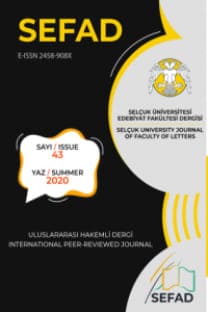Yazı ve Benlik: John Fowles’ın Kurgu Dışı Otobiyografik Yazıları
Yirminci yüzyıl İngiliz Edebiyatı’nın en önemli romancıları arasında yer alan John Robert Fowles, daima şiir ve felsefe yazmak istediğini iddia eder. Kurgusal eserlerine gösterilen ilginin kurgu dışı yazılarına olan eksikliğine rağmen, Fowles tıpkı kurgusal eserlerinde yaptığı gibi kurgu dışı yazılarında da bir yazar, özellikle de bir romancı olmanın ne anlama geldiğini gösterir. Fowles’ın bazı yazıları oldukça verimli bir romancı olarak kendisinin yazıya olan tutku ve saplantısını belirtir. Örneğin yazı yazmanın tıpkı aşk gibi doğallığından bahseder. Bunun yanında Fowles’ın yazıları okuyucuya kurgusal eserlerinde zaten ele aldığı kavram ve düşünceleri hatırlatır. Bütün bunlara ek olarak, Fowles yazılarında kendisinin en bilinen ve yirminci yüzyıl İngiliz Edebiyatı’nın en beğenilen romanları arasında yer alan bir eserinin, terk edilmiş bir iskelenin ucunda durup denize bakan bir kadın imgesinin sonucu olduğunu itiraf eder. Karşılaştığı zorluklardan bahsetmekten de çekinmez. Fowles için yazı kişisel bir uğraştır. Kurgu başka dünyalar yaratmaktır. Hatta romancının kendi karakterine aşık olduğu ilahi bir oyundur.
Anahtar Kelimeler:
Yazı, kurgu, kurgu dışı, benlik, itiraf
Writing and the Self: John Fowles’ Autobiographical Non-Fiction
One of the greatest novelists of the twentieth-century English Literature, John Robert Fowles (1926-2005), claims that he has always wanted to write poetry and philosophy. Despite the lack of the same critical interest in his non-fiction as in his fiction, it is his non-fiction as well as his fiction where Fowles makes clear what it means to him to be a writer, and a novelist in particular. Some of Fowles’ essays specially represent his obsessions with and passions for writing as a prolific novelist. He says, for example, referring to this idea that writing is a natural process like love. Moreover, Fowles’ essays quickly remind the reader of especially his fiction of the notions and the themes that he has already dealt with in his novels. In addition to all these, Fowles surprisingly confesses in one of his essays that a simple image of a woman standing at the end of a deserted quay and staring out to sea was how one of his most famous and one of his most acclaimed novels of the twentieth-century English literature came to life (This novel is the writer’s 1969 work, The French Lieutenant’s Woman.). Fowles, in his essays, does not hesitate to talk about the difficulties he had either. Writing, for Fowles, is a very personal business. Fiction making is creating another world. It is a godgame where the novelist even falls in love with his heroine.
Keywords:
Writing, fiction, non-fiction, self, confession,
___
- ACHESON, James (1998). Modern Novelists: John Fowles. New York: Macmillan Education.
- ALTUNSOY, Safak (2010). “Cultural Reception of the Place Images in the poems of Mark Doty and Murathan Mungan, a Turkish Poet”. Jeden Swiat Wiele Kultur. Eds. Marka Bednarza and Wojciecha Jurkiewicza. Bydgoszcz: Kujawy and Pomorze UP.
- BAKER, James R. (1980). “Fowles and the Struggle of the English ‘Aristoi’”. Journal of Modern Literature VIII (2): 163-180.
- BUCHBERGER, Michelle Phillips (2012). “John Fowles’ Novels of the 1950s and 1960s”. The Yearbook of English Studies XLII: 132-150.
- CAMPBELL, James (1976). “An Interview with John Fowles”. Contemporary Literature XVII (4): 455-469.
- COOPER, Pamela (1991). The Fictions of John Fowles: Power, Creativity, Femininity. Ottawa: U of Ottawa P.
- DOCHERTY, Thomas (1981). “A Constant Reality: The Presentation of Character in the Fiction of John Fowles”. Novel: A Forum on Fiction XIV (2): 118-134.
- EDDINS, Dwight (1976). “John Fowles: Existence as Authorship”. Contemporary Literature XVII (2): 204-222.
- ERDEM METE, Defne (2017). “Developing Empathy through Writing in an EFL Composition Class”. Journal of Teaching and Education VI (2): 49-52.
- FOWLES, John (1970). The Aristos. New York: The New American Library.
- FOWLES, John (1998). Wormholes: Essays and Occasional Writings. London: Vintage.
- KERİM, Leyla (2015). “Afanasiy Fet’in ‘Rüya’ Adlı Eserinde Psikanalitik Yaklaşım”. International Journal of Languages, Education and Teaching. III (1): 246-55.
- LENZ, Brooke (2008). John Fowles: Visionary and Voyeur. New York: Rodopi.
- ONEGA, Susana (1996). “Self, World and Art in the Fiction of John Fowles”. Twentieth Century Literature XLII (1): 29-57.
- SINGH, Raman K. (1980). “An Encounter with John Fowles”. Journal of Modern Literature VIII (2): 181-202.
- VIPOND, Diana (1996). ‘An Unholy Inquisition’. Twentieth Century Literature XLII (1): 12-28.
- WILSON, Raymond J. (1990). “Fowles's Allegory of Literary Invention: Mantissa and Contemporary Theory”. Twentieth Century Literature XXXVI (1): 61-72.
- WILSON, Thomas M. (2006). The Recurrent Green Universe of John Fowles. New York: Rodopi.
- Yayın Aralığı: Yılda 2 Sayı
- Başlangıç: 1981
- Yayıncı: Selçuk Üniversitesi Edebiyat Fakültesi
Sayıdaki Diğer Makaleler
Yabancı Dil Olarak Türkçe Öğretiminde Öğrenci Memnuniyeti
Beyşehir’in Huğlu Kasabasında Yaşayan Türkmenlerin Belirgin Ağız Özellikleri
Börükçü’den Bir Grup Siyah Figürlü Lekythos
Sınıf Öğretmenlerinin Boş Zaman Değerlendirme Farkındalıkları: İzmir Örneği
Pelin ÖNDER EROL, Belgin ARSLAN CANSEVER, Neşe ASLAN
Afyon Gedik Ahmet Paşa Cami Taçkapısı
Christophe Colomb'un Caniba ya da Cannibale'i ile Aime Cesaire'ın Caliban'ı
Filiz Özdem’in Sırlarla Dolu Konak Adlı Eserinde Deyimler
Anlamca Kaynaşmış Birleşik Fiiller: Almanca ve Türkçe Gazete Metinlerinde Bir Çözümleme
Derya Koray DÜŞÜNCELİ, Zeki USLU
Raymond Carver’in A Small, Good Thing Adlı Hikâyesinde Eşduyum Duygularının Etkinleştirilmesi
